
3 December 2019. We are happy and proud to share that Scientific Reports has published our latest research on the effects of fluctuating CO2 × O2 environments on the early life stages of Atlantic Silversides. The paper synthesizes findings of two years and four separate experiments – all conducted in our automated larval fish rearing system – to answer the question how current and future diel and tidal fluctuations in CO2 and O2 affect the survival and growth of silverside embryos and larvae.
The paper is a great demonstration of the vast capabilities of our system to simulate non-static conditions, which is a frontier in climate change research. Congrats to Emma Cross for pulling all the complex data together!
Diel and tidal pCO2 × O2 fluctuations provide physiological refuge to a coastal forage fish
Scientific Reports 9:18146



From the Abstract:
“Static low DO conditions severely decreased embryo survival, larval survival, time to 50% hatch, size at hatch and post-larval growth rates. Static elevated pco2 did not affect most response traits, however, a synergistic negative effect did occur on embryo survival under hypoxic conditions (3.0 mg L−1). Cycling CO2 × DO, however, reduced these negative effects of static conditions on all response traits with the magnitude of fluctuations influencing the extent of this reduction. This indicates that fluctuations in pco2 and DO may benefit coastal organisms by providing periodic physiological refuge from stressful conditions, which could promote species adaptability to climate change.”
The source data for this publication are openly available (and citable) from the BCO-DMO database. Head to Products -> Research Data to access them!
